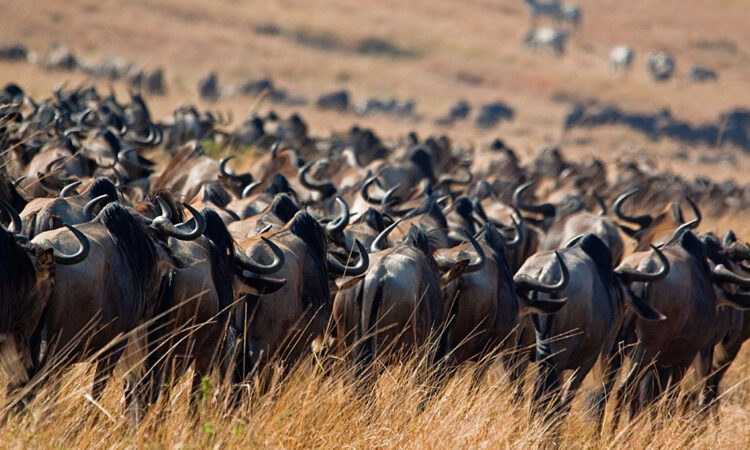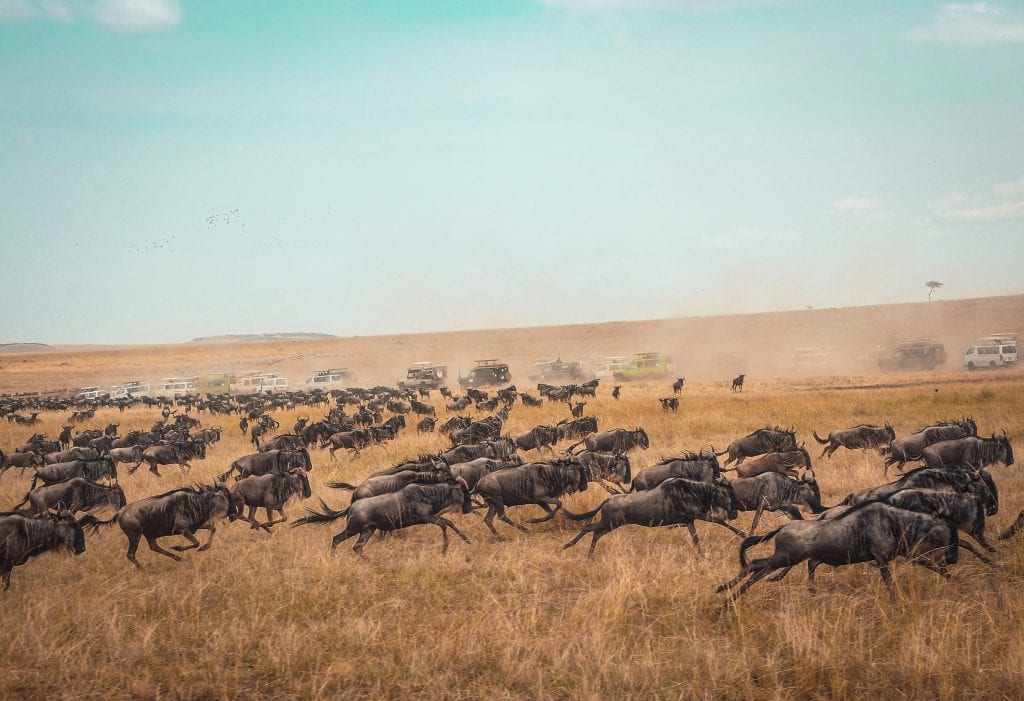The Great Wildebeest Migration : Witnessing Nature’s Spectacle in Kenya and Tanzania : The Great Wildebeest Migration is one of the most extraordinary wildlife spectacles on Earth, captivating nature enthusiasts and adventure seekers from around the world. Spanning the grassy plains of Kenya’s Maasai Mara National Reserve and Tanzania’s Serengeti National Park, this annual migration showcases the dramatic journey of millions of wildebeest, zebras, and other herbivores as they traverse vast distances in search of food and water. In this comprehensive travel article, we will delve into the wonders of the Great Wildebeest Migration, provide insights into the migration’s patterns and routes, and guide you on an unforgettable journey to witness this awe-inspiring natural phenomenon in Kenya and Tanzania.

Understanding the Great Wildebeest Migration:
The Great Wildebeest Migration takes place between the Maasai Mara National Reserve in Kenya and the Serengeti National Park in Tanzania, two of Africa’s most iconic wildlife reserves. The expansive plains and diverse landscapes of these protected areas provide the perfect habitat for the wildebeest herds to graze and breed.
The migration is a continuous cycle that follows the rhythm of the seasons and the availability of food and water. The journey begins in the southern Serengeti, where the herds give birth to their young between January and March. As the dry season approaches, the herds start moving northward, crossing the Grumeti and Mara rivers, facing dangerous river crossings and encounters with predators. By August, they reach the Maasai Mara in Kenya, where they graze on the lush grasslands until October. With the onset of the short rains, they begin their return journey to the Serengeti.
The Great Wildebeest Migration is not only about the wildebeest. It is an ecosystem-wide event that involves a vast array of species. Alongside the wildebeest, zebras, gazelles, and elands also participate in this mass movement. Predators such as lions, cheetahs, leopards, and crocodiles seize the opportunity to hunt, creating dramatic and often heart-pounding encounters. The migration is a prime example of the delicate balance of nature and the interdependence of different species.
Planning Your Great Wildebeest Migration Safari:
The timing of your visit is crucial to witness the migration at its peak. The wildebeest herds’ exact movements can vary from year to year, depending on weather patterns and food availability. However, generally, the best time to witness the river crossings is from July to October when the herds are in the Maasai Mara. The calving season from January to March in the southern Serengeti is also a remarkable time to observe the newborns.
To maximize your chances of witnessing the Great Wildebeest Migration, it’s advisable to book a safari with experienced guides and reputable tour operators who are familiar with the migration patterns and have extensive knowledge of the area. They can navigate the ever-changing landscapes and position you in the best locations to observe the migration and capture breathtaking photographs.
Both the Maasai Mara and the Serengeti offer a range of accommodation options to suit different budgets and preferences. From luxury lodges and tented camps to mobile campsites that move with the migration, you can choose accommodations that provide comfort while allowing you to immerse yourself in the heart of the action. It’s recommended to book well in advance, especially during the peak migration months, to secure your preferred accommodations.
Experiencing the Great Wildebeest Migration:
Witnessing a river crossing is the pinnacle of the Great Wildebeest Migration experience. As the herds gather on the riverbanks, anticipation fills the air. With a surge of energy, the wildebeest plunge into the river, braving strong currents and lurking crocodiles. This spectacle of chaos and determination is both exhilarating and heart-wrenching, showcasing the raw power of nature.
Embark on game drives in the Maasai Mara National Reserve and Serengeti to explore the vast landscapes and observe the abundant wildlife. Knowledgeable guides will take you to strategic viewpoints, where you can witness the migration up close and marvel at the intricate social dynamics and survival strategies of the animals. For a unique perspective, consider a hot air balloon safari, floating silently above the plains and witnessing the expansive herds from a bird’s-eye view.

Take the opportunity to connect with the local communities and learn about their traditional ways of life. Visit Maasai villages, interact with the Maasai people, and gain insight into their rich cultural heritage. Engage in cultural exchanges, participate in traditional ceremonies, and support local initiatives that promote community development and conservation efforts.
Responsible Tourism and Conservation:
Support conservation organizations and initiatives that strive to protect the fragile ecosystems and wildlife populations of the Maasai Mara and Serengeti. By visiting responsibly, adhering to park regulations, and minimizing your ecological footprint, you contribute to the long-term sustainability of these pristine areas.
While observing the migration, it’s essential to maintain a respectful distance from the wildlife and abide by the guidance of your guides. Avoid disturbing the animals or altering their behavior for the sake of a photograph. Remember that you are a guest in their natural habitat.
The Great Wildebeest Migration is a natural phenomenon of unparalleled beauty and significance. Witnessing the mass movement of millions of animals across the plains of Kenya and Tanzania is a humbling and awe-inspiring experience that connects us with the intricate workings of the natural world. As you plan your safari to witness this spectacle, prioritize responsible tourism, immerse yourself in the local cultures, and embrace the wonder of nature as you become a part of this extraordinary journey.


